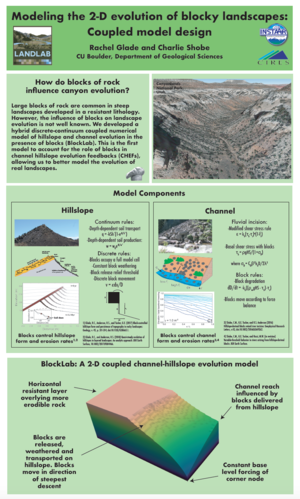2018 CSDMS meeting-033: Difference between revisions
Glader011235 (talk | contribs) (Created page with "{{CSDMS meeting personal information template-2018 |CSDMS meeting first name=Rachel |CSDMS meeting last name=Glade |CSDMS meeting institute=INSTAAR |CSDMS meeting city=Boulder...") |
No edit summary |
||
| (3 intermediate revisions by 2 users not shown) | |||
| Line 20: | Line 20: | ||
}} | }} | ||
{{CSDMS meeting select clinics3 2018 | {{CSDMS meeting select clinics3 2018 | ||
|CSDMS_meeting_select_clinics3_2018= | |CSDMS_meeting_select_clinics3_2018=5) Will not attend a clinic | ||
}} | }} | ||
{{CSDMS scholarships yes no | {{CSDMS scholarships yes no | ||
| Line 29: | Line 29: | ||
}} | }} | ||
{{CSDMS meeting abstract title temp2018 | {{CSDMS meeting abstract title temp2018 | ||
|CSDMS meeting abstract title=Modeling the 2-D evolution of blocky landscapes: | |CSDMS meeting abstract title=Modeling the 2-D evolution of blocky landscapes: Coupled model design | ||
}} | |||
{{CSDMS meeting abstract template 2018 | |||
|CSDMS meeting abstract=Large blocks of rock are common in steep landscapes developed in the presence of a resistant lithology. However, the influence of blocks on landscape evolution is not well known. We developed a hybrid discrete-continuum coupled numerical model of hillslope and channel evolution in the presence of blocks (BlockLab). The model consists of a horizontal resistant layer of rock overlying softer, more erodible rock. A channel reach, driven by an external base level forcing, incises through the middle of the domain and provides the base level for the hillslopes. The hillslope model uses a continuum approach to treat depth-dependent production and transport of soil. Retreat of the resistant layer, however, is treated discretely. A relief threshold determines release of discrete blocks from the resistant layer onto the hillslope, where each model cell is either filled with blocks or contains no blocks. These blocks are allowed to weather at a constant rate, and are tracked as they move downslope according to a relief threshold related to their diameter. Once blocks enter the channel, they influence channel evolution by covering the bed and reducing available bed shear stress. A force balance on in-channel blocks determines whether they can move downstream. Blocks in the channel are reduced in size by abrasion according to the shear stresses exerted on them. The presence of blocks affects channel incision rates, in turn influencing evolution of the hillslopes. This is the first model to account for the role of blocks in channel hillslope evolution feedbacks (CHEFs), allowing us to better model the evolution of real landscapes. | |||
|CSDMS meeting posterPDF=Glade_CSDMS_POSTER_May2018.pdf | |||
|CSDMS meeting posterPNG=Glade_CSDMS_POSTER_May2018.png | |||
}} | }} | ||
{{blank line template}} | {{blank line template}} | ||
Latest revision as of 19:37, 25 May 2018
Log in (or create account for non-CSDMS members)
Forgot username? Search or email:CSDMSweb@colorado.edu
Browse abstracts
Modeling the 2-D evolution of blocky landscapes: Coupled model design
Large blocks of rock are common in steep landscapes developed in the presence of a resistant lithology. However, the influence of blocks on landscape evolution is not well known. We developed a hybrid discrete-continuum coupled numerical model of hillslope and channel evolution in the presence of blocks (BlockLab). The model consists of a horizontal resistant layer of rock overlying softer, more erodible rock. A channel reach, driven by an external base level forcing, incises through the middle of the domain and provides the base level for the hillslopes. The hillslope model uses a continuum approach to treat depth-dependent production and transport of soil. Retreat of the resistant layer, however, is treated discretely. A relief threshold determines release of discrete blocks from the resistant layer onto the hillslope, where each model cell is either filled with blocks or contains no blocks. These blocks are allowed to weather at a constant rate, and are tracked as they move downslope according to a relief threshold related to their diameter. Once blocks enter the channel, they influence channel evolution by covering the bed and reducing available bed shear stress. A force balance on in-channel blocks determines whether they can move downstream. Blocks in the channel are reduced in size by abrasion according to the shear stresses exerted on them. The presence of blocks affects channel incision rates, in turn influencing evolution of the hillslopes. This is the first model to account for the role of blocks in channel hillslope evolution feedbacks (CHEFs), allowing us to better model the evolution of real landscapes.

